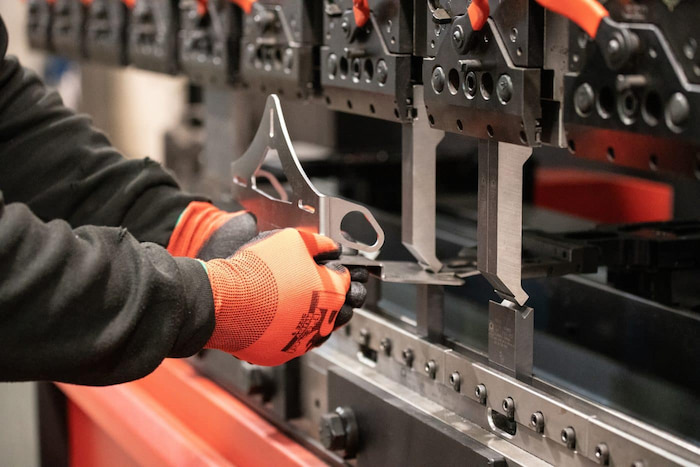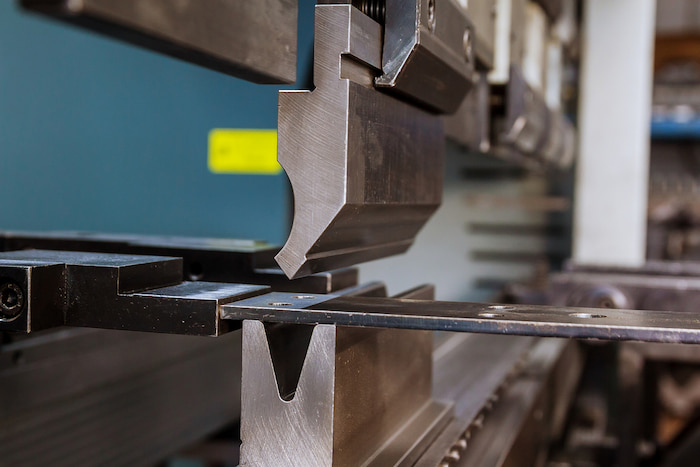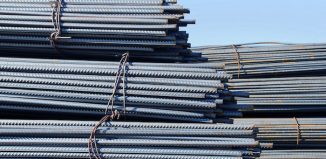Sheet metal is used in hundreds of industries. Carbon steel is good enough for car panels, rust-resistant galvanised steel sheets in boat hulls and engine parts, while higher strength stainless steel features in specialised uses ranging from aeroplane fuselages to food processing machinery. Add to this aluminium sheet in everyday items like tin cans to sewage drains and copper in electrical appliances, piping and decorative household items. All need to be formed and machined into the desired shape for them to fulfil their intended purpose. This is where press brakes come in. They’re the machinery used by metal fabricators to bend and shape metal sheets to suit specified needs and applications. Every fabricating workshop dealing with sheet metal has at least one.
What Are Press Brakes?
Press brakes are heavy-duty machinery used for all sorts of sheet metal fabrication. The machines clamp metal sheets between a punch and die and use force to get the desired bend. They have their origins in rudimentary devices from the onset of the industrial age, but the press brake as we know it today is a reworked and advanced version of the first machine invented in 1882. Constant advancements since then have meant these machines are now available as hydraulic and electric types and are miles ahead in terms of capability and features of basic mechanical machines used a century ago.

Parts in a Press Brake and How It Works
Despite the differences in design and how they muster enough force to bend metal, all press brake machines consist of a frame, a bed, a ram, a die, a back gauge and in CNC types, a controller. The frame is what keeps the whole assembly together and has left and right vertical plates, which suspend the worktable or bed and have a movable ram. The bed is the smooth surface where metal sheets are inserted and held in place. The ram is the moving component that moves up and down and bends the metal by applying pressure to the sheet while it is sitting against the die. The role of the position of the sheet is assigned to the back gauge. Advanced CNC machines use preprogrammed software dialled in with specifics like sheet sizes and required angles to speed up the process and remove any instances of human error.
Common Types and Applications
There are several types of press brakes, each with its own set of advantages and metals and applications they’re best suited to. Mechanical presses haven’t seen any significant changes from their inception, but have adequate clamping force in thinner gauged sheets, being relatively simple and quick to operate. They’re good in both mild and stainless steel, as well as copper, brass and aluminium in general fabrication and more specialised uses in structural steel fabrication, HVAC ducting parts and components used in cars and aeroplanes.
Choose a hydraulic press brake when working with thicker metal sheets and plates as this has ample bending power. Hydraulics offer dependable and consistent results, as well as tooling for more complex tasks and possible shapes. The machines will take up more floorspace and are in line with other heavy-duty machinery and equipment such as rotary screw compressors, but offer extended versatility. They build on the uses of mechanical press brakes, but can also shape strengthened alloys with pressures (or tonnage) exceeding 250 tons in bigger units.
Electric variants are the most recent design, often having a smaller footprint, but rivalling hydraulic units for bending power. Here a system of servo motors provides the needed tonnage. The machines are quieter too, generally need less maintenance, and can include CNC programming for extreme precision. Both types though are considerably more expensive, but very efficient and accurate in getting complex geometries in exotic metals like titanium and Inconel used in high-end parts and components. And they work faster in regular sheet pieces made of mild and stainless steel.

What to Look For When Buying
Before buying any press brake, consider the materials you’re working with. This is not only limited to sheet thickness, hardness or type but also the shaping requirements and ductility of each metal workpiece. Press brakes need enough tonnage to effortlessly bend the material, and have compatible tooling dies to get complex shapes. If you only work with thinner gauge metals and only need basic bends, then a low-tonnage machine should meet most needs. However, for complicated tasks and more precision in thicker sheets or metal plates, consider machines with higher tonnage. For high-volume, industrial use look to variants with 40 tons of pressure or more.
Of course, you’ll also need to appropriately size the machine to the materials. Here the most important factor is bed length. This can be anywhere from 1.2 to 4.3m (4′ to 14′). Related is the ram stroke, or the distance the ram can travel when bending the sheet to the desired depth. Needless to say, machines with bigger beds, and more ram stroke are also more costly, but will also have higher tonnage.
Lastly, look at features, ease of use and safety. NC and CNC machines have complex designs, some working along 7 independent axes. This though simplifies use, cuts down operating times and boosts productivity. The machines also remove safety risks, but even basic manually-operated units should have essential safety features such as emergency stop buttons to cut power, light curtains to detect fingers, hands and other body parts and interlocks to prevent unsafe actions.











